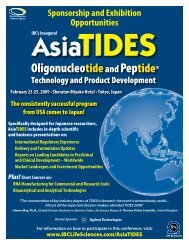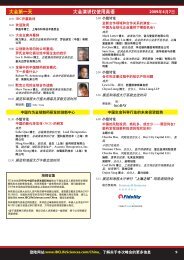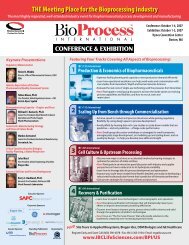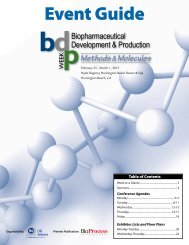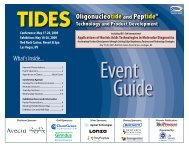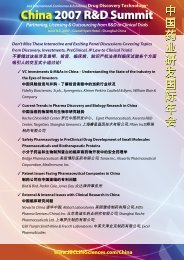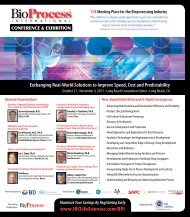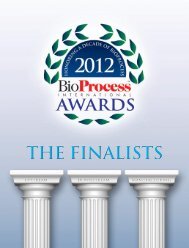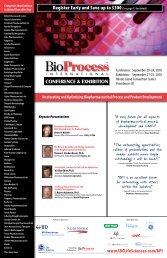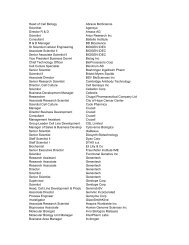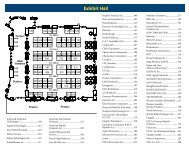Cell Culture & Upstream Processing - IBC Life Sciences
Cell Culture & Upstream Processing - IBC Life Sciences
Cell Culture & Upstream Processing - IBC Life Sciences
Create successful ePaper yourself
Turn your PDF publications into a flip-book with our unique Google optimized e-Paper software.
Tuesday, September 23, 2008 • Main Conference (continued)<br />
11:45 Concurrent Technology Workshops<br />
POROS® Chromatography Media:<br />
Transforming Your Downstream Process<br />
The features and benefits of POROS® chromatography<br />
media as they relate to improving downstream<br />
purification will be discussed. Learn how POROS<br />
media are differentiated and the benefits to downstream<br />
purification. Process modeling will be used to highlight<br />
potential productivity gains.<br />
Christine Gebski, Process Applications Manager,<br />
Applied Biosystems<br />
Optimizing <strong>Cell</strong> <strong>Culture</strong> Data Management<br />
and Process Control through OPC Technology<br />
Rapidly becoming an industry standard, OPC enables realtime<br />
data exchange between multiple vendors’ devices and<br />
the control systems that support them. We’ll show how NBS’<br />
new software can integrate your fermentor to metabolite<br />
analyzers, turbidity probes, scales, or third party software.<br />
The possibilities are endless and the advantages are clear<br />
– optimizing process control and improving quality control in<br />
support of PAT initiatives, with less time, effort and cost.<br />
Richard Mirro, Product Manager,<br />
New Brunswick Scientific<br />
12:15 Luncheon Presentation<br />
Economic Modeling of Single-Use Systems<br />
The potential economic benefits of single-use systems over<br />
traditional stainless steel systems are of increasing interest<br />
to the bioprocessing industry. This presentation examines<br />
modeling systems for specific applications including<br />
liquid storage, mixing, bioreactor processing and entire<br />
manufacturing flows. The return on investment models<br />
shown address key areas of operational, strategic and<br />
economic benefits. The models also provide customer-specific<br />
guidance concerning both direct and indirect benefits.<br />
Eric Isberg, Manager, Single-Use Process Systems,<br />
Thermo Fisher Scientific<br />
High Throughput Process Development: Promises, Myths, and Truths<br />
The ultimate goal of the process development team is to stay off the critical path to drug approval. To increase the effectiveness of the development<br />
process, many companies are turning to the use of high throughput (HT) technologies within their development platforms. In this workshop we<br />
will describe our experience with the implementation of three such HT technologies. We have learned that there are at least four keys to successful<br />
automation implementation, some of which could be anticipated and some of which are less obvious. Our experience will be shared.<br />
Peggy Lio, Process Science Fellow, Invitrogen Corporation<br />
1 Production & Economics of Biopharmaceuticals 2 Scaling Up from Bench through Commercialization<br />
Production Planning for<br />
Cost-Efficient Manufacture<br />
1:45 Chairperson’s Remarks<br />
Rhona M. O’Leary, Ph.D., Director,<br />
BioProcess Development, Genentech, Inc.<br />
2:00 Research in Biopharmaceutical Operations:<br />
Advancing the State of the Art<br />
Biopharmaceutical research has traditionally focused on drug discovery, but with a<br />
maturing industry facing cost pressures there is increased need for pre-competitive<br />
research into wider issues around manufacturing and logistics, an approach that<br />
has greatly benefited other high-technology industries. We review several projects<br />
underway at the UC Berkeley Center for Biopharmaceutical Operations, focusing<br />
on explorations of risk and its impact across the supply chain.<br />
Philip Kaminsky, Ph.D., Associate Professor, Department of Industrial Engineering<br />
and Operations Research, University of California, Berkeley<br />
Rick Johnston, Co-Director, Center for Biopharmaceutical Operations,<br />
University of California, Berkeley<br />
2:30 Managing Production in Light of Uncertain Demand Forecasts<br />
During the first few years of commercial production in a new market, there can<br />
be significant uncertainty in demand forecasts. The relationship between demand<br />
and capacity for biologics can be very linear, so to accommodate some variability,<br />
elasticity can be added in the form of plant utilization choices and inventory<br />
control which can help to moderate the impact of demand swings. These<br />
approaches will be presented.<br />
Alison Moore, Ph.D., Vice President and Site Head, Amgen Inc.<br />
3:00 Production Planning in Light of Uncertainty<br />
ZymoGenetics launched a hospital-based product with entirely<br />
outsourced manufacturing. Robust quality and supply agreements<br />
with flexible forecasting mechanisms were critical. Close management of release<br />
cycle times and the impact on inventory levels and response time to changes in<br />
forecasts will be discussed. Finally, a case study of an expedited launch involving<br />
detailed planning and coordination between various contract manufacturers and<br />
internal resources will be presented.<br />
Joe McKinstry, Associate Director, Production Planning & Inventory Control,<br />
ZymoGenetics, Inc.<br />
Regulatory Updates: Tools for QbD<br />
(Quality by Design) Implementation<br />
1:45 Chairperson’s Remarks<br />
Jeffrey C. Baker, Ph.D., Senior Research Advisor, Manufacturing <strong>Sciences</strong> and<br />
Technology, Eli Lilly and Co.<br />
2:00 Approaches to Defining Design Space for Bioprocesses<br />
Defining the design space for a bioprocess is an essential component of the<br />
Quality by Design approach to product development. Pfizer has implemented a<br />
comprehensive "Right First Time" approach to the development and commercial<br />
manufacture of biological products. This approach includes a structured<br />
methodology for risk assessment and experimental prioritization that facilitates<br />
the establishment of functional relationships between process parameters and<br />
quality attributes. This presentation will focus on implementation of this approach<br />
for a biologic product candidate, and demonstrate possible approaches to defining<br />
design space for bioprocesses.<br />
Natarajan Ramasubramanyan, Ph.D., Senior Principal Scientist, Pfizer Inc<br />
2:30 PCA/PLS Similarity Factors for<br />
Batch-to-Batch Comparisons<br />
This talk addresses pairwise comparison of fermentation and cell culture<br />
batches. In early development, there may only be a few batches available, from<br />
which performance guidelines must be set for manufacturing. Similarity factors<br />
from PCA/PLS models can be used for comparison of batches. This technique<br />
compares process models to look for differences in input-output relationships.<br />
The talk will discuss the similarity factor approach and include examples using<br />
pilot data.<br />
Jeremy Conner, Ph.D., Senior Engineer, Amgen Inc.<br />
3:00 Application of Multivariate Analysis (for Large Scale Data) and<br />
DOE (at Small Scale) to Understand Key Process Inputs for a<br />
<strong>Cell</strong> <strong>Culture</strong> Process<br />
Multivariate analysis (MVA) of large scale data was used to study the relationships<br />
between various offline, online, and raw material parameters. The resulting effects and<br />
interactions were further studied via small scale studies using univariate experimentation<br />
as well as by DOE. The raw material DOE study confirmed that interactions do exist<br />
between various raw materials and demonstrated the value of performing comprehensive<br />
DOE studies as part of qualification of a raw material for the process.<br />
Sanjeev Ahuja, Ph.D., Senior Scientist, <strong>Cell</strong> <strong>Culture</strong> Process Development,<br />
MedImmune<br />
Concurrent with<br />
1:45 - 3:30 Special Strategy Discussion Forum: Adopting New Technology: The Cost of Change See next page for details<br />
Visit www.<strong>IBC</strong><strong>Life</strong><strong>Sciences</strong>.com/BPI/US for up-to-date information on this event 7





